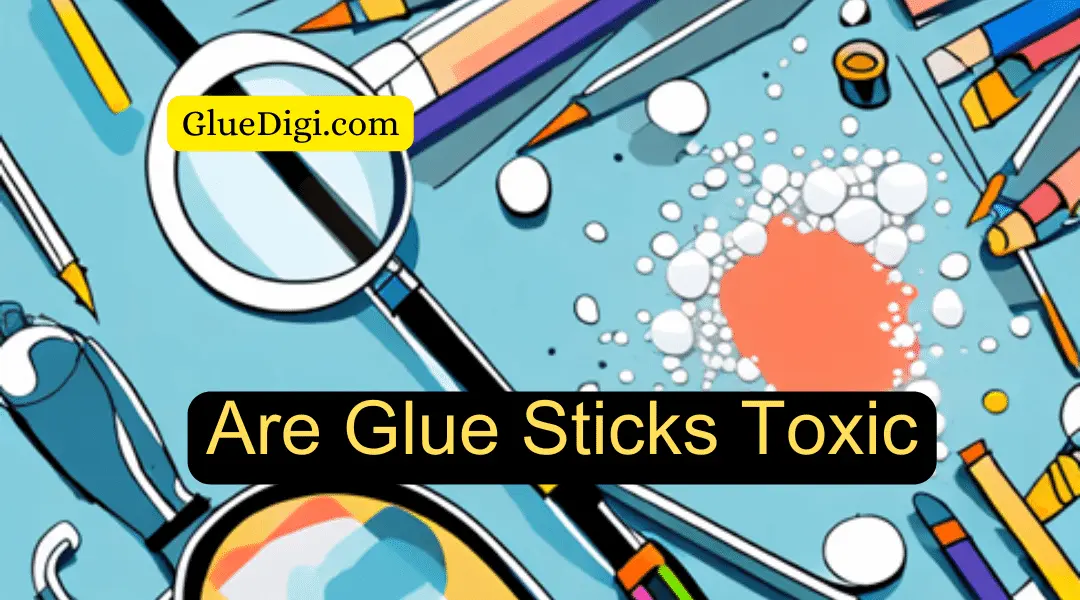Glue sticks are a common household and office item, used for a variety of purposes such as scrapbooking, attaching labels, and binding paper. While these sticky tools may seem harmless, there has been some concern regarding their potential toxicity. Are glue sticks truly toxic to our health? In this article, we will explore what experts say about glue stick toxicity, analyze the chemicals involved, and understand the potential risks of glue stick exposure.
Let’s dive into this peculiar topic and uncover the taste, health risks, and even unique uses of glue beyond its intended purpose.
Toxic Chemicals in Glue Sticks: What You Need to Know
The primary concern regarding glue stick toxicity revolves around the chemicals present in these adhesives. Polymers, tackifiers, and solvents are among the substances included in the majority of glue sticks. Some of these compounds may produce minor allergic responses or irritability in some people. But it’s crucial to distinguish between a really hazardous reaction and sensitivity or discomfort.

While the toxicity of glue sticks is a concern, it is important to note that they are generally safe when used as intended. However, it is still crucial to be aware of the potential risks associated with them.
One particular chemical often scrutinized is polyvinyl acetate, a synthetic polymer used to make most school glue sticks.
According to studies, polyvinyl acetate poses no threat to human health when utilized in common glue sticks. Glycerin, a typical component that serves as a binder and plasticizer, is another one. The widespread consensus is that glycerin is both harmless and non-toxic.
Despite the low toxicity of glue sticks, care should be taken while using them, particularly when around small children or anyone who already have health problems. Although uncommon, direct absorption or inhalation of glue stick contents may have harmful consequences on one’s health.
Uncovering the Truth About Glue Stick Toxicity
A rising number of scientists have investigated the toxicity of glue sticks in recent years. Most research comes to the conclusion that glue sticks offer no harm to human health when used as intended. This does not imply that they are completely risk-free, however.
It is important to remember that some people could be more sensitive than others to the chemicals included in glue sticks. People who already have respiratory or skin problems may be more prone to irritability or allergic responses.
Furthermore, it is yet unclear how regularly exposing oneself to glue stick compounds may affect one over the long run. Use of these adhesives must be done in a well-ventilated location, and prolonged or repetitive exposure should be avoided.
Glue sticks are usually seen to be safe to use, but it’s still necessary to be aware of any possible hazards. You may securely make use of the convenience of these handy adhesives by taking the necessary measures and using them as directed.
Glue Stick Ingredients: What the Experts Say
Knowing the components that go into making a glue stick is crucial when choosing one. Polyvinyl acetate, a synthetic polymer often found in adhesives, is a component of the majority of glue sticks. This component provides glue sticks their stickiness, making it simple for them to adhere to paper, cardboard, and other materials.
In addition to polyvinyl acetate, many glue sticks also contain glycerin, a natural compound that helps to keep the glue moist and pliable. This ingredient is particularly important for preventing the glue from drying out and becoming unusable over time.
Other non-toxic ingredients that are safe for individuals of all ages, including small children, may be included in glue sticks. These include water, colorants, and preservatives.
It’s important to keep in mind, however, that certain glue stick brands may include traces of more dangerous compounds, such as formaldehyde. A colorless gas called formaldehyde is often used to make adhesives and other industrial goods. Although most glue sticks contain relatively little formaldehyde, it’s nevertheless vital to be aware of this possible health risk.
People should actively hunt for items branded “non-toxic” or “safe for children” to guarantee safety when using glue sticks. These items have undergone testing and are safe for use by people of all ages, including small children.
Is Glue Stick Exposure Hazardous to Your Health?
While most glue stick ingredients are considered non-toxic, prolonged or excessive exposure can still lead to some health issues. For example, if the glue stick emits strong odors or fumes, inhaling them for extended periods can irritate the respiratory system. This can lead to symptoms such as coughing, wheezing, and shortness of breath.
Additionally, if the glue comes in contact with the skin or eyes, it may cause irritation, redness, or itching. This is particularly true for individuals with sensitive skin or allergies.
More severe symptoms including nausea, vomiting, or stomach discomfort may manifest in extreme circumstances, such as after consuming a significant quantity of glue. Because of this, it’s crucial to always abide by the manufacturer’s instructions for appropriate use and to operate in a well-ventilated area while using glue sticks.
Overall, glue sticks are a safe and convenient option for bonding paper, cardboard, and other materials. However, it’s important to be aware of the potential hazards associated with prolonged or excessive exposure and to take steps to minimize these risks whenever possible.
Examining the Safety of Glue Sticks
It’s important to take into account aspects like correct use, chemical toxicity, and possible health impacts when evaluating the overall safety of glue sticks. As was already noted, when used as instructed, the majority of glue sticks are regarded as safe and non-toxic. Nevertheless, care should always be taken to prevent unneeded exposure to or absorption of the adhesive.
The possible effects of glue sticks on the environment must also be taken into account. Many of these goods are made of synthetic polymers that come from petrochemicals and other non-renewable resources. When feasible, using environmentally friendly, biodegradable, or sustainable alternatives may help us preserve the advantages of adhesive tools while lowering our impact on the environment.
Glue sticks are often used in classrooms, workplaces, and homes for a variety of tasks including crafts, scrapbooking, and regular maintenance. They are simple to use and provide a fast, clean solution to bind cardboard, paper, and other light materials. It’s important to remember, however, that glue sticks are not appropriate for demanding tasks or joining materials like metal, glass, or ceramics.
Investigating the Risks of Glue Stick Usage
Although glue sticks are usually thought to be safe, it is important to pay attention to any cautions or disclaimers that the manufacturer may have included. The inappropriate use of certain items might have negative effects that could be hazardous. certain products might not be appropriate for use on certain materials or surfaces.
Accidental ingestion is among the biggest dangers connected to using glue sticks. Children in particular risk choking or poisoning if they mistake glue sticks for sweets or other edible objects. To avoid mishaps, it’s essential to keep glue sticks out of children’s reach and to monitor their usage.
When used in conjunction with other potentially dangerous products, such as sharp objects or combustible chemicals, the hazards of using glue sticks are increased even more. When using glue sticks, always use care and put safety first, particularly if there are children or people with special needs present.
Finally, glue sticks provide a fast and simple technique to join lightweight materials. They are often secure and practical adhesive equipment. But it’s important to use them correctly, pay attention to any cautions or disclaimers, and think about how their use can affect the environment. We may make use of the advantages of glue sticks while reducing any hazards involved by following these safety measures.
Glue Stick Toxicity: What Science Says
According to scientific studies on glue stick toxicity, these products are generally safe for regular use. Mild irritability or allergic responses are the most common dangers linked with glue sticks. More serious health effects are very uncommon and mostly limited to situations when the substance is intentionally misused or used.
Glue sticks are often used in workplaces, homes, and classrooms for a variety of tasks. They provide a strong binding and are simple to use. However, some individuals may be worried about the toxicity and safety of glue sticks.
The majority of glue sticks’ constituents, according to a National Institutes of Health Research, are non-toxic and do not significantly endanger human health. The main component of glue sticks is polyvinyl acetate, a water-soluble polymer often found in coatings, paints, and adhesives. Even while additional chemicals like colorants, stabilizers, and preservatives may be included, they are often non-toxic and harmless.
That being said, it is crucial to exercise caution and safety precautions while using glue sticks, especially around weaker people, children, and those who are prone to allergies or other sensitivities. It is advised to use glue sticks in an area with good ventilation and to limit exposure time. If you encounter any negative effects, such as skin rashes or breathing issues, stop using the product right once and get medical help.
Glue Sticks: Are They Dangerous or Not?
In conclusion, when used as directed, glue sticks are usually considered secure and non-toxic. Most glue sticks available on the market are made with ingredients that offer little to no harm to human health. Although some people who are exposed to glue sticks may feel irritation or pain, these responses are often moderate and do not point to a true hazardous response.
While glue sticks are often harmless, there are a few exceptions that should be noted. Some industrial-strength glue sticks could include risky substances like toluene or methylene chloride, which are dangerous if consumed or breathed. These glue sticks should only be used in well-ventilated environments and with care.
It is crucial to use glue sticks safely, according to the recommended safety precautions and manufacturer recommendations. Glue sticks may continue to be a useful and adaptable tool for different uses in our daily lives by being cautious and adopting the required safety measures.
Overall, scientists agree that glue sticks are safe when used as intended. However, just like with any product, it’s crucial to use them properly and follow the right safety precautions. We may continue to profit from glue sticks in this way without having to worry too much about our health and well-being.
Is Glue Stick Exposures Dangerous?
When used as intended, glue sticks are not harmful to brief exposure. However, prolonged or excessive exposure, such as breathing in fumes or consuming glue, might have a negative impact on one’s health. It is vital to get prompt medical help in these uncommon situations.
Glue sticks are a common option since they are extensively used as an adhesive tool in a variety of contexts, from arts and crafts projects to industrial uses. Although glue sticks are typically safe to use, it is important to be aware of any potential risks.
The possibility of breathing fumes is one of the main risks associated with glue sticks. When heated, glue sticks emit fumes that, if breathed in sufficient amounts, may be dangerous. Long-term exposure to these chemicals might cause breathing problems including bronchitis or asthma.
The possibility of ingesting glue sticks is another possible concern. Although eating glue sticks won’t make you sick, it may cause blockages in the digestive system, which can be serious and call for medical treatment.
Always maintain a well-ventilated environment and abide by any safety instructions given by the manufacturer to reduce any possible risks related to glue stick exposure. Choosing non-toxic, kid-safe glue sticks is especially crucial when dealing with kids or in a classroom.
The Potential Dangers of Glue Sticks: What You Need to Know
Understanding the possible risks associated with using glue sticks is essential. When utilizing these sticky instruments, it is still important to move cautiously and put safety first, even if the majority of glue stick exposure situations are non-toxic and often harmless.
Take the necessary safety measures before using glue sticks. Always operate in a well-ventilated location, and use a mask or respirator to prevent breathing in fumes. Additionally, it’s important to keep glue sticks away from children and pets, prevent eating them, and keep them out of their reach.
Seek urgent medical treatment if using glue sticks causes any negative health consequences. Exposure to glue sticks may cause symptoms such as headaches, nausea, dizziness, or trouble breathing.
The risks connected with using glue sticks may be kept to a minimum by adhering to the right safety procedures and using non-toxic, kid-safe glue sticks. Always seek advice from a professional or study the product’s safety instructions if you are unsure.
Conclusion:
Is Glue Sticks Toxic? Although glue sticks are safe to use, you should exercise caution when doing so in situations where kids could be present. The majority of these locations are hardware and home improvement businesses. Always use eye protection and follow the correct safety practices while using glue sticks.
Solvents used in glue sticks have the potential to be hazardous if breathed or consumed. It is crucial to use them in accordance with the correct safety precautions since they may also irritate the skin and eyes if spilled upon.
Avoid touching the tips of glue sticks and keep them out of children’s reach at all times. Glue sticks should never be left alone since they rapidly burn or melt. Always put out any fires started by glue sticks with water as soon as they occur.




